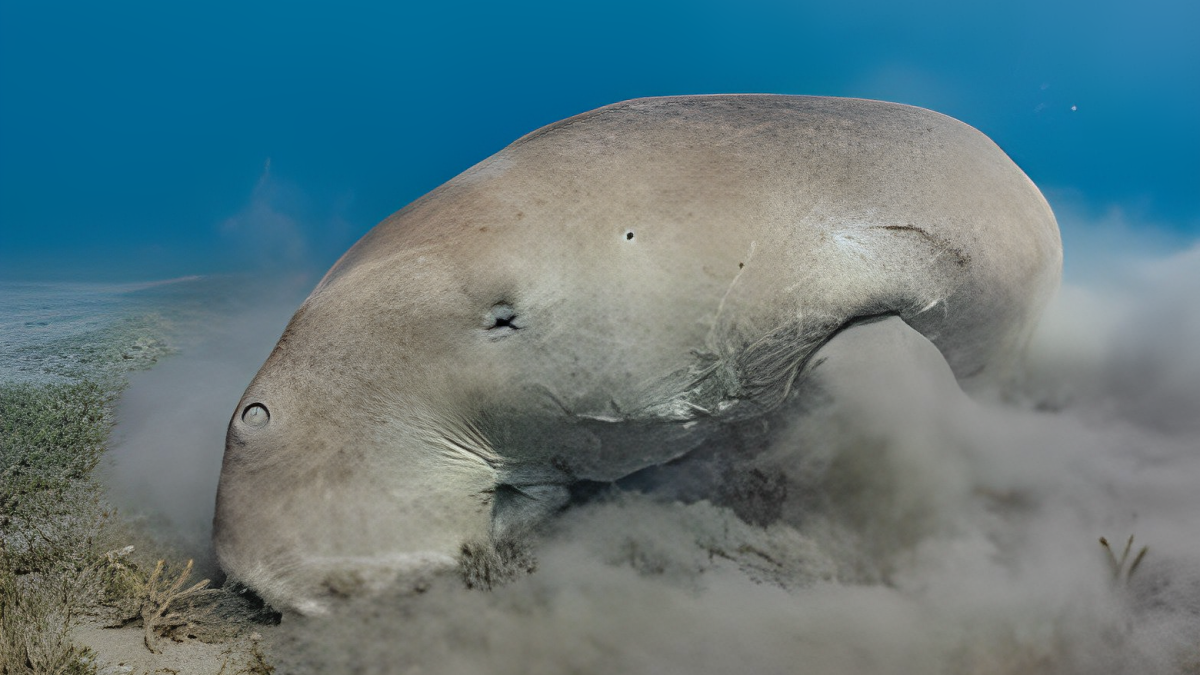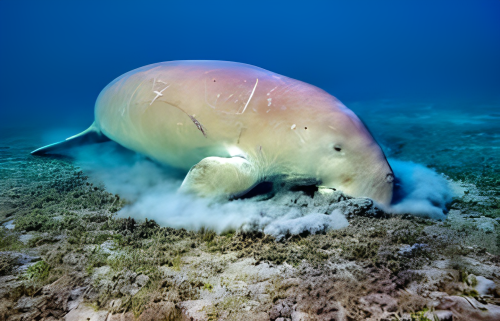Dugong, the Seagrass Guardians

Photo Credit : Alekss-sp/Shutterstock
Dugongs, also known as sea cows, or duyung in Indonesia local language, are marine mammals that can be found in the warm waters of the Indian Ocean and Western Pacific. In Indonesia, dugongs have been observed in various regions, including the coastal waters of Sumatra, Java, Kalimantan, Sulawesi, Bali, East Nusa Tenggara (NTT), Maluku, and West Papua. However, scientific information on the abundance, distribution, and behavior of dugongs in Indonesian waters is still very limited.
Dugongs have a body length of about 2.4-3 meters and a body weight between 230 to 908 kilograms. They have long fins on the chest, with fin lengths ranging from 35 to 45 centimeters. These fins, along with the tail, serve as thrusters and rudders. Dugongs have a slow reproduction rate. They reproduce by viviparous, and are usually ready to breed upon reaching the age of 10. The length of pregnancy of a dugong is 12 to 14 months, and after delivery, the baby dugong will breastfeed for 1 to 2 years.
Dugongs are herbivorous animals and spend a lot of time feeding on seagrass beds, which are grasslands in shallow or coastal waters. Seagrass meadows in Indonesia reach about 15 percent of the world's total seagrass beds. According to the National Research and Innovation Agency (BRIN), the area of seagrass meadows in Indonesia that have been verified and validated by satellite images or through field observations reaches 293,464 hectares.
Dugongs can be an indicator of seagrass conditions, because they can only live in seagrass beds with healthy conditions. In a day, a dugong can consume as much as 25 to 30 kilograms of seagrass plants. Only a few types of seagrass plants can be consumed by dugongs, namely halodule, halophila, and cymodecea. This type of seagrass has a soft texture and can be digested easily by these marine mammals. Dugongs have a very slow digestive system, which is for 146 to 166 hours.
Unfortunately, the dugong population in Indonesia is declining. Incidental fishing (bycatch) and stranding of dugongs in gill nets, as well as direct hunting are the main reasons for this decline. Dugong meat and skin that have been dried are usually consumed by local people, while the fangs are traded across regions at prices ranging from Rp1-3 million per fang. There is still a belief that dugong tears are a powerful for anti-aging, so dugongs are often hunted with the ultimate goal of taking their tears.
Dugong Conservation in Indonesia
Dugong conservation must involve various parties. The community can contribute to the preservation of dugongs and other marine fauna such as turtles, whales, or dolphins by not throwing garbage, household waste, or industry into the sea that can pollute the waters and threaten the life of existing ecosystems and species. In addition, people can also help by not buying products derived from dugongs, so that the rate of hunting in nature can be suppressed.

Photo Credit : Agami Photo Agency/Shutterstock
The government also has plans to conserve dugongs and seagrass beds. Indonesia's Dugong and Seagrass Conservation Project (DSCP) program is run through a collaboration between the Directorate of Marine Conservation & Biodiversity of the Ministry of Marine Affairs and Fisheries, the Oceanographic Research Center - Indonesian Institute of Sciences (now become BRIN), the Faculty of Fisheries and Marine Sciences - Bogor Agricultural University, and the WWF-Indonesia Foundation, with support from the United Nations.
To aid in the preservation and reduce the decline in the population of this species, the public can contribute in various ways such as learning and disseminating information about dugongs and seagrasses to raise awareness of those around them.
In addition, the public can also report dugong deaths and pollution in seagrass meadows to the authorities, avoid littering, especially into the sea, and always support the conservation efforts of the Government of Indonesia, one of which is through DSCP Indonesia. The public is also urged to avoid purchasing dugong body parts, both in raw and processed form.
It is hoped that conservation efforts of dugongs and seagrass beds will continue and be improved. Through cooperation between governments, non-governmental organizations, and communities, we can create a better environment for dugongs and other species that depend on seagrass beds. A healthy and breeding dugong population in Indonesian waters, with extensive and healthy seagrass beds, will not only benefit the dugong, but also for the many other species that depend on seagrass meadow ecosystems. In addition, success in the preservation of dugongs and seagrass beds will also be a symbol of Indonesia's success in maintaining and preserving its marine biodiversity.

